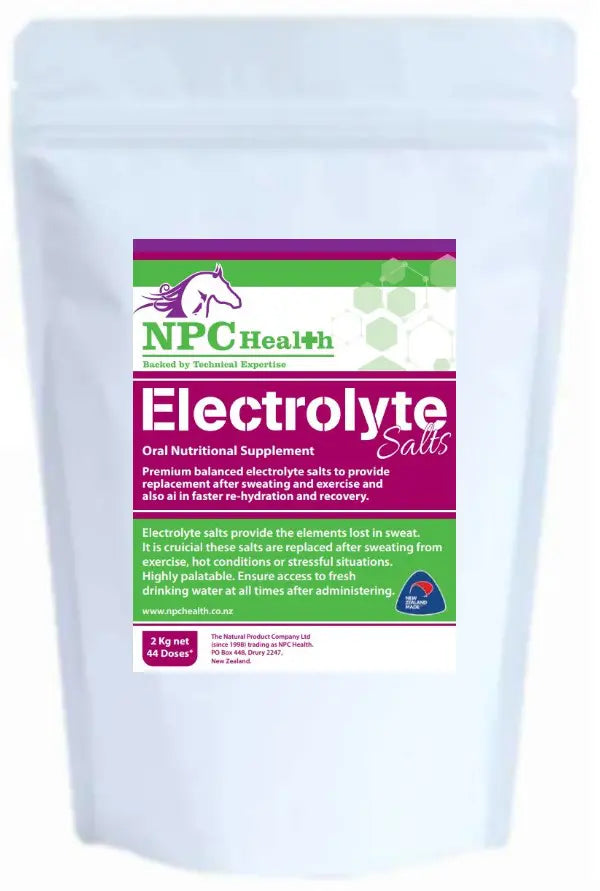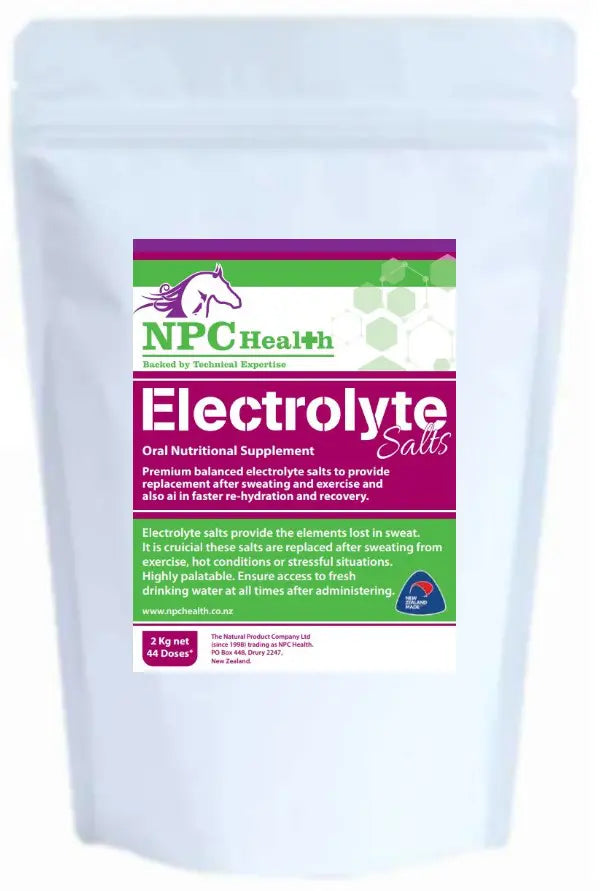NPC Health Electrolytes for horses
- Regular price
-
$38.00 - Regular price
-
- Sale price
-
$38.00
Estimated Shipping Widget will be displayed here!
Couldn't load pickup availability
Electrolytes for horses is a horse supplement especially formulated to replenish lost salts in sweating horses and those working in hot conditions.
Electrolytes work by replacing lost salts in sweat, which also drives the thirst response, the horse will feel thirsty and drink. Therefore, will also rehydrate. The combination of electrolytes and water therefore restores body balance and quickly aids recovery in your horse.
Electrolytes are recommended in hot weather conditions and after sweating has taken place. Always ensure access to water after administering and never provide electrolytes then ride or travel without ensuring your horse drinks. Electrolytes without water will cause dehydration. The horse must drink some time after electrolytes are given.
Electrolytes for horses consist of Sodium, Chloride, Potassium, Calcium and Magnesium. which are lost in sweat and should be replaced after sweating has taken place. By replenishing salts after sweating homeostasis (body balance) can be restored.
The sequence: RESTORE, replace lost salts. This drives the thirst response encourages drinking for HYDRATION. The rebalance of electrolytes will RECHARGE your horse!
Electrolytes therefore help to; RESTORE, RE-HYDRATE, RECHARGE!
Horses lose more than salt (sodium and chloride) in sweat and in particular heavy sweating horses in hot conditions.
Ordinary salt can be fed daily (1 tablespoon per 500 Kg horse) but as sweating increases Electrolytes should be added in addition to your daily salt regime. We recommend splitting feeds, so it does not become too salty into AM and PM feed where Electrolytes are administered after working the horse. Always ensure water is available after feeding any salt product as Electrolytes will (also) make your horse extremely thirsty.ele
Shipping Info
Shipping & Pickup Information
Flat Rate Shipping via Post Haste (Excludes Feed):
- North Island: $10 (1-2 working days)
- South Island: $20 (2-3 working days)
- Rural Surcharge: +$6 (extra time may apply)
Feed Shipping per bag via Post Haste:
- Central North Island: $14 Per Bag
- Upper North Island: $18 Per Bag
- Lower North Island: $28 Per Bag
- South Island: $55 Per Bag
- Rural Surcharge: +$6 (extra time may apply)
Orders placed before 1 PM are usually shipped the same day.
Click & Collect:
- Free 24/7 pickup via our after-hours collection box.
- Instructions will be emailed when your order is ready.
Returns & Exchanges
No problem! We offer 30-day returns and exchanges on all items in new, resalable condition with the original packaging. See our full policy.
FAQ
All your questions, answered.

The thermoneutral zone is the temperature range where the body can maintain its core temperature with little to no extra energy expenditure. For humans, this range is quite narrow at 21–28 °C, but for horses it’s much broader at 5–25 °C.
This difference means we should avoid rugging horses based on how cold we feel. Over-rugging can lead to serious health issues, including metabolic problems and thermoregulatory dysfunction.
Tips for Choosing a Winter Rug Weight
-
Clipped horses may need a heavier gram fill to stay comfortable.
-
Remember: horses warm themselves more easily than they cool down under a rug. If unsure, choose a lighter rug.
-
Check your horse regularly to make sure they are neither too hot nor too cold.
-
Consider your horse’s age and natural ability to stay warm.
-
As a general guide, rugging is usually appropriate when temperatures drop below 5–10 °C, but always adjust for your horse’s individual needs.
-
Always ensure rugs are waterproof. A wet rug is worse than no rug at all.
This is an indicative guide only. Always take into account factors such as wind chill, your horse’s age, weight, and condition.




